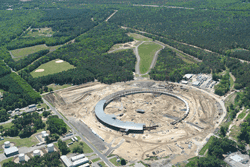Light source project promises next gen of sustainable energy
A little more than a year ago, the U.S. Department of Energy’s Brookhaven National Laboratory (Upton, NY) announced the construction of the world’s most brilliant light source, called the National Synchrotron Light Source II (NSLS-II). This project will enable the next generation of sustainable energy. Now the DOE has announced the approval to begin conceptual design of NSLS-II experimental tools, named NEXT.

NSLS-II under construction.
The research potential of NSLS-II will only be realized when it is equipped with scientific instruments known as beamlines. Specialized magnets called insertion devices will create the light used by the most advanced of these beamlines. Currently, the NSLS-II project is building six beamlines with insertion devices. NEXT would support the creation of another five or six insertion device beamlines. NSLS-II will be able to support up to 58 beamlines. Additional beamlines for NSLS-II would be funded by various other sources over time.
According to Steve Dierker, NSLS-II Project Director and Associate Laboratory Director for Light Sources at Brookhaven Lab, “Much of the research at NSLS-II will focus on developing the next generation of sustainable energy technologies.” According to Dierker, these new technologies will be based on novel materials that have yet to be designed and fabricated
Current technologies are built using bulk materials. However, the properties in bulk materials are not sufficient to enable next-generation technologies. Even researchers today have not succeeded at improving their properties by the amount needed for the new applications. BNL hopes that the NEXT project can give NSLS-II the advanced tools to do that.
The NSLS, which is BNL’s current operating light source, draws 2,200 researchers a year to study a wide range of materials, from catalysts, to computer chips, to biological molecules. However, scientists need more intense, better-focused light in order to probe even smaller, subtler details of their samples. NSLS-II promises to deliver world-leading intensity and brightness, producing x-rays 10,000 times brighter than the current NSLS. In fact, it has been noted that its x-ray brightness and resolution will exceed all other light sources available today. This will enable the nanoscience revolution, giving scientists the ability to image materials down to a nanometer, one billionth of a meter — a capability not available at any other light source in the world. This will further enhance national security and help drive the development of abundant, safe, and clean energy technologies.
For more information, contact Kendra Snyder at 631- 344-8191, e-mail ksnyder@bnl.gov or Peter Genzer at 631-344-3174, e-mail genzer@bnl.gov.
Christina Nickolas
Advertisement
Learn more about U.S. Department of Energy Brookhaven National Laboratory





